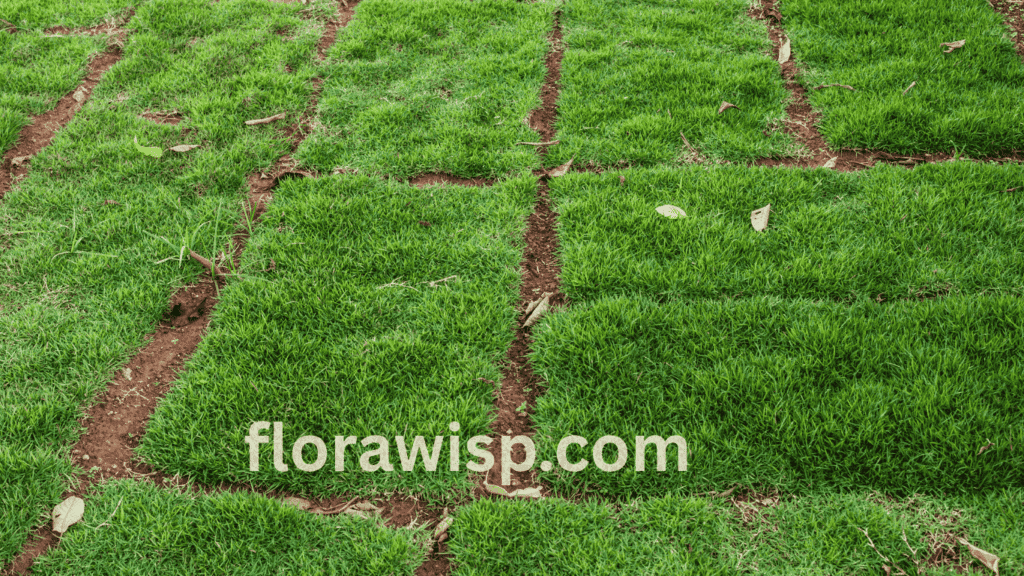If you’re looking for a beautiful, durable lawn in Florida’s challenging climate, Zoysia grass in Florida might be your perfect match. With its dense growth, heat tolerance, and soft texture, Zoysia is quickly becoming a go-to choice for both homeowners and landscapers across the Sunshine State. In this guide, we’ll dive into the best Zoysia grass types, planting methods, care tips, and even how Zoysia compares to other popular Florida grasses. Whether you’re starting from scratch or renovating your lawn, this article will help you make informed decisions backed by experience and research—and if you’re in a different region, explore how to grow Zoysia grass in Texas for equally stunning results.
In This Article
Why Choose Zoysia Grass in Florida?
Florida’s warm, humid climate demands grass varieties that can withstand heat, occasional drought, and intense rainfall. Grasses like Bermuda, Zoysia in Florida ticks all those boxes. Over my years as a gardening enthusiast, I’ve seen Zoysia outperform many other grass types in Florida lawns especially when maintained properly.
Key reasons Zoysia thrives in Florida:
- Heat & drought resistance
- High tolerance to foot traffic
- Low water requirements once established
- Resilient in both full sun and partial shade
Many Florida homeowners often ask, “Does Zoysia grass grow in shade?” The answer is yes, especially varieties like Zeon Zoysia, which tolerate partial shade quite well. Its lush green blades give your lawn that golf-course look while being soft underfoot.
Best Types of Zoysia Grass In Florida
Creating a lush Zoysia grass lawn in Florida starts with choosing the right variety. One that suits your region, soil, and upkeep preferences. Below is a breakdown of the most recommended kinds of Zoysia grass for Florida homeowners:
1. Zeon Zoysia Grass
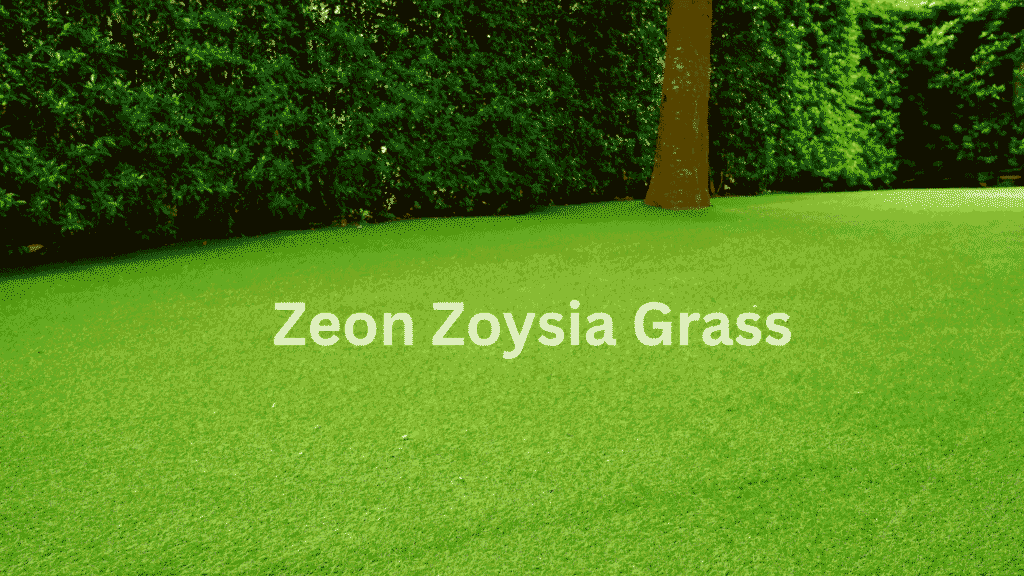
- Fine-bladed, vibrant green
- Great for moderate shade
- Soft texture and high drought tolerance
2. Empire Zoysia Grass Seed
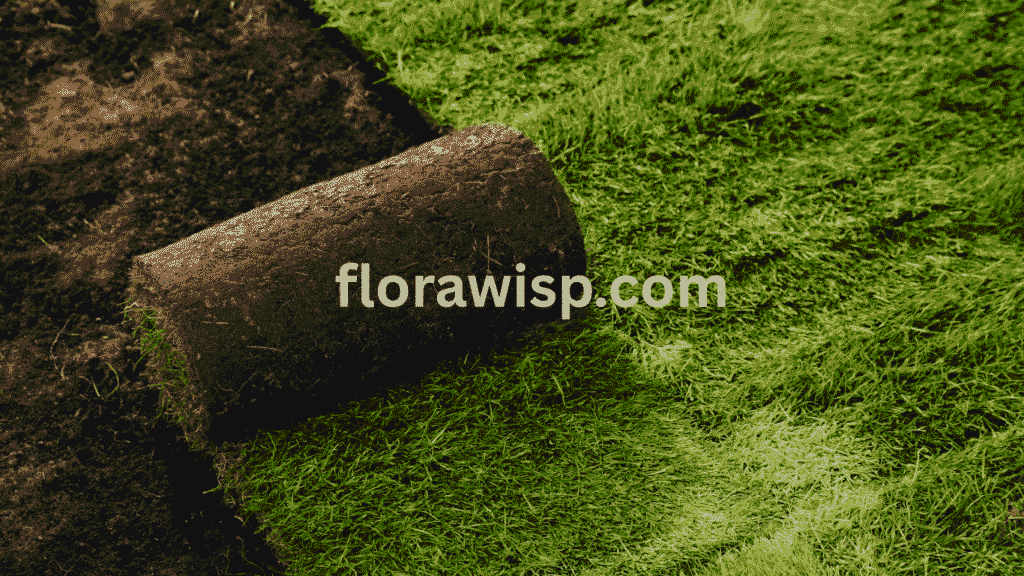
- Coarser texture
- Excellent wear resistance
- Great for high-traffic areas
3. Zenith Zoysia Grass Seed
- One of the few Zoysia types available as seed
- Ideal for DIY lawn projects
- Tolerant of sun and moderate shade
4. Emerald Zoysia Grass Seed
- Dense and fine-bladed
- Great visual appeal
- Best for well-maintained lawns with partial sun
5. El Toro Zoysia Grass
- Fast-growing and highly adaptable
- Responds well to mowing and fertilization
6. Zorro Zoysia Grass
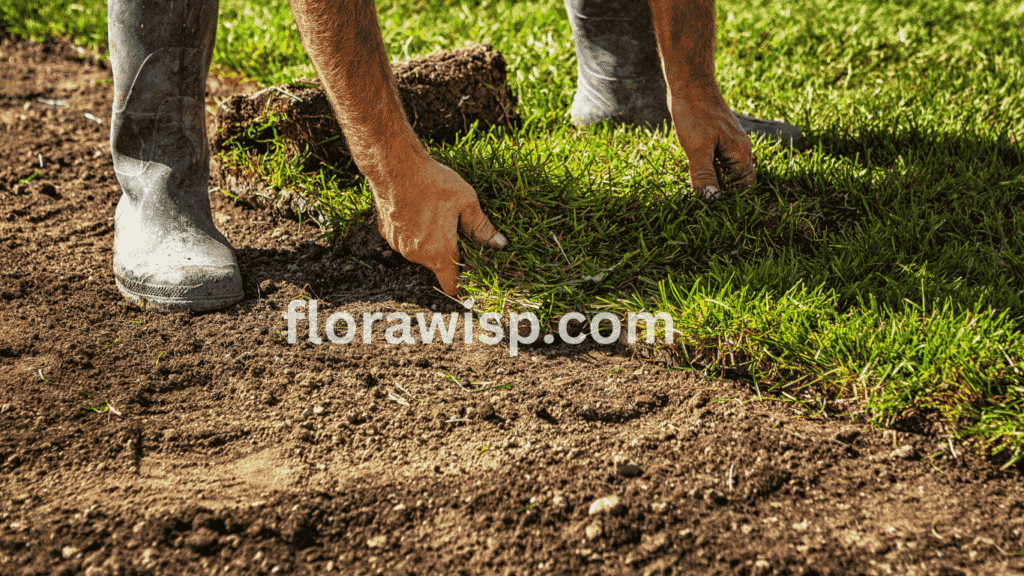
- Fine texture and deep green color
- Excellent for southern climates like Florida
These Zoysia grass types vary in appearance and maintenance needs. If you’re looking to plant from seed, Zenith grass seed Zoysia is the most accessible option for Florida homeowners.
Planting Zoysia Grass Seed in Florida
Zoysia grass seed Florida growers should pay close attention to planting time and preparation. The best time to plant is during late spring to early summer when soil temperatures reach 70°F or higher.
How to plant Zoysia grass in Florida:
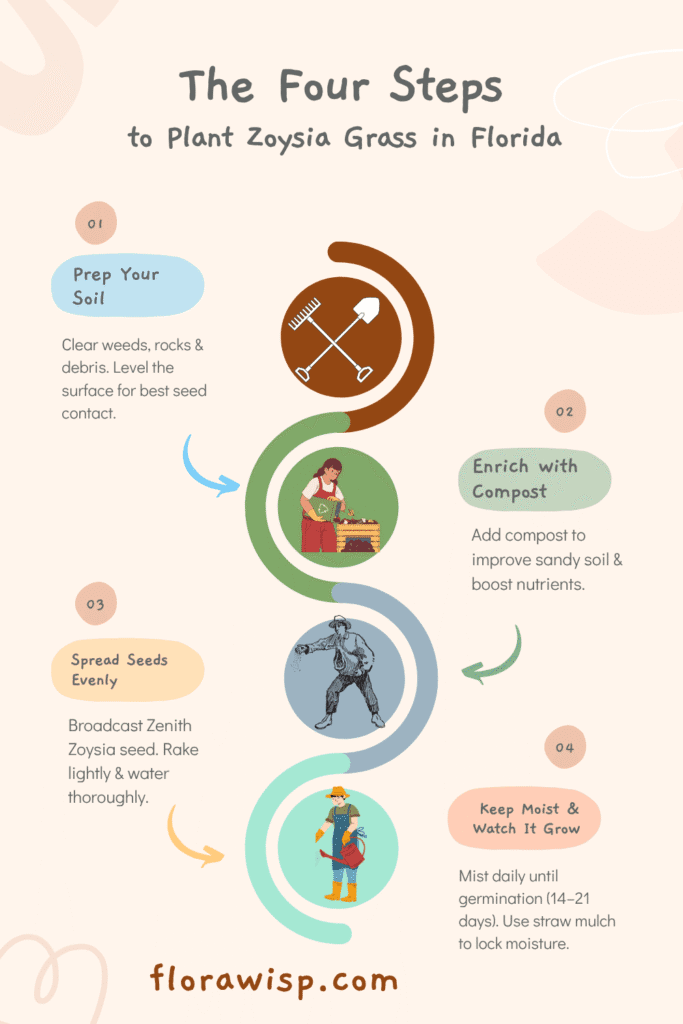
- Clear and level the soil – Remove all weeds, rocks, and debris. A smooth surface ensures even seed contact.
- Add compost or organic matter – Florida soils can be sandy; enriching them boosts water retention and nutrient content.
- Spread Zenith Zoysia grass seed evenly – Use a broadcast spreader for uniform coverage.
- Lightly rake and water thoroughly – This helps settle seeds into the soil without burying them too deep.
- Keep moist until germination (14–21 days) – Mist the area daily. I’ve found using straw mulch helps retain moisture and protect the seeds.
Alternatively, use sod or plugs for faster results. Plugs are cost-effective and ideal for varieties like El Toro or Empire Zoysia, which spread well and establish faster in Florida’s warm conditions. I often recommend plugs for patchy lawns where full re-seeding isn’t necessary.
Zoysia Grass Fertilizer Schedule for Florida Lawns
Proper fertilization is essential for a healthy, vibrant Zoysia lawn in Florida’s unique climate. Below is a practical fertilizer schedule based on seasonal needs and my experience as a gardener working with Florida soils.
| Season | Fertilizer Type | Application Tips |
| Spring (Mar–Apr) | Balanced fertilizer (e.g., 16-4-8) | Apply after the lawn starts greening up; water lightly after application. |
| Summer (Jun–Jul) | Slow-release nitrogen fertilizer | Used to sustain growth during Florida’s hot months; avoid excessive nitrogen to prevent thatch. |
| Early Fall (Sept) | Light feeding with balanced or low-nitrogen fertilizer | Prepares grass for dormancy; helps strengthen roots. |
Personal Tip: In Florida’s sandy soils, I’ve found that supplementing with organic amendments like compost tea or seaweed extract boosts soil health and reduces chemical reliance. It also helps the grass better tolerate heat and occasional drought.
Remember, over-fertilizing can cause thatch buildup and invite pests. Always follow recommended rates and adjust based on your lawn’s specific needs and rainfall patterns. Consistent, moderate feeding delivers the best long-term results for Zoysia grass in Florida.
Common Zoysia Grass Problems In Florida (with Solutions)
Zoysia is resilient, but Florida’s humidity and rainfall can trigger several Zoysia grass problems. Here are the most common issues and how to solve them:
1. Brown Spots
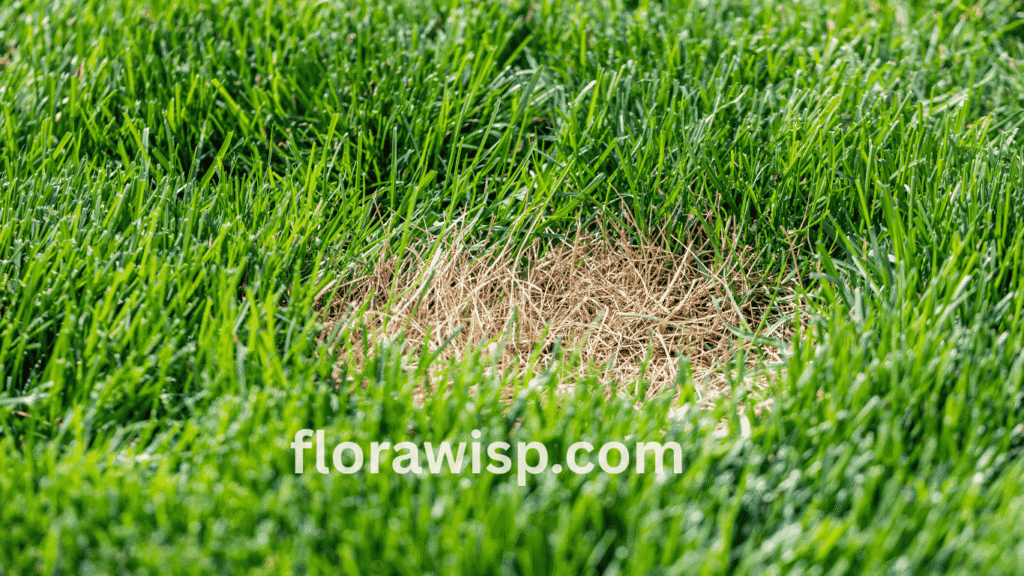
- Caused by fungus, overwatering, or poor drainage
- Solution: Apply fungicide and improve soil aeration
2. Thatch Buildup
- Excess organic layer can suffocate roots
- Solution: Dethatch annually and mow at the correct height
3. Insect Infestation
- Mole crickets and chinch bugs are common pests
- Solution: Apply targeted insecticides and monitor turf regularly
4. Slow Spring Green-Up
- Zoysia may take longer to recover from dormancy
- Solution: Apply light spring fertilizer and keep soil warm and well-drained
5. Compacted Soil
- Often due to foot traffic on wet ground
- Solution: Aerate soil to promote deeper root growth
6. Overwatering Issues
- Leads to disease and root rot
- Solution: Water deeply but infrequently; improve drainage if needed
7. General Maintenance Tips
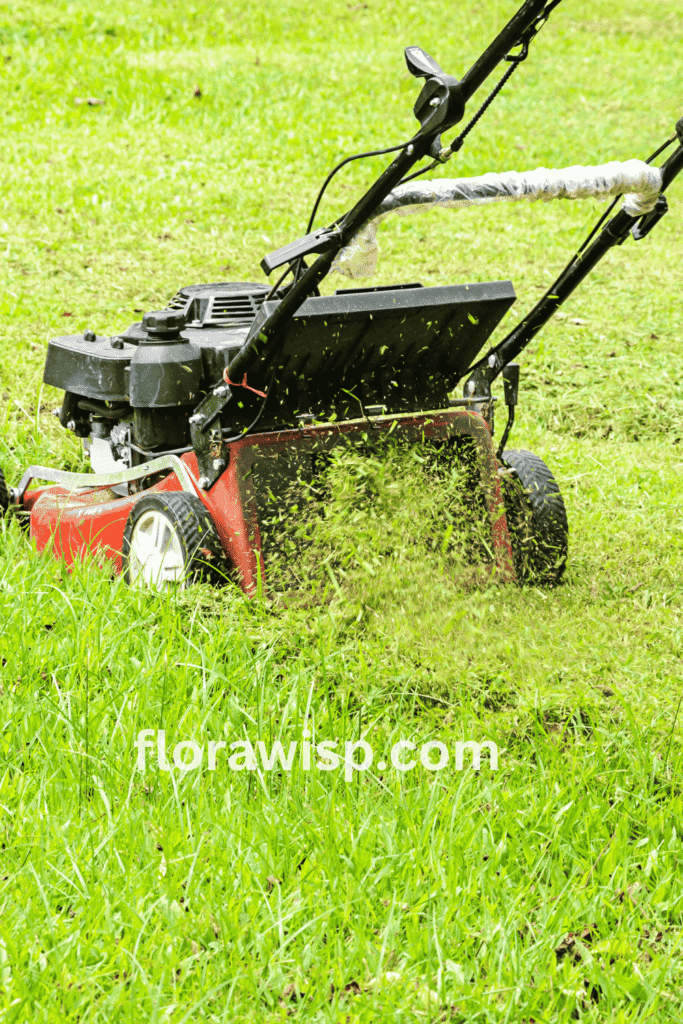
- Mow at 1.5–2.5 inches
- Fertilize moderately
- Inspect regularly for discoloration or thinning patches
Florida’s humid climate speeds up both growth and damage. Regular care and quick response are key to a healthy Zoysia lawn.
Monthly Zoysia Grass Care Calendar For Florida
Creating a tailored Zoysia grass care calendar ensures your lawn stays healthy year-round in Florida’s diverse seasons. From my experience, consistency is more important than perfection. Here’s a seasonal breakdown to guide your care routine:
| Month | Activity |
| Jan–Feb | Let Zoysia rest during dormancy; avoid fertilizing or mowing |
| Mar–Apr | Dethatch and apply balanced fertilizer; mow as growth resumes |
| May–Jun | Begin regular mowing; apply nitrogen fertilizer; monitor for pests |
| Jul–Aug | Water deeply; mow weekly; treat for brown patch and other fungi |
| Sep–Oct | Light fertilizer before dormancy; lower mowing height slightly |
| Nov–Dec | Reduce mowing; keep lawn clean of debris; Zoysia grass in winter rests |
Adjust irrigation based on rainfall and temperature. In winter, Zoysia grass in Florida may turn brown not due to poor health, but dormancy. Don’t panic; it will green up beautifully come spring.
What Does Zoysia Grass Look Like?
Zoysia grass is visually striking and highly desirable for homeowners aiming for a lush, uniform lawn. It typically has a fine to medium blade texture depending on the variety Zeon and Emerald have finer blades, while Empire and El Toro offer a slightly coarser texture. The color ranges from light to deep green, with a soft, cushiony feel underfoot that makes walking barefoot a pleasure.
Well-maintained, Zoysia grass in Florida forms a dense, carpet-like layer that naturally resists weeds and enhances curb appeal. It has a horizontal growth habit and spreads through both stolons and rhizomes, which helps fill in bare patches over time. During cooler months, Zoysia may go dormant and turn golden-brown, but it re greens quickly in spring with proper care.
Final Thoughts:
If you’re aiming for a low-maintenance, lush, and resilient lawn in Florida, Zoysia grass stands out as one of the best choices. With a wide range of varieties from the shade-tolerant Zeon to the easily sown Zenith seed you can find the perfect fit for your landscape needs and local conditions.
In my own experience, making the switch from St. Augustine to Zoysia transformed my lawn’s health and appearance. While the upfront cost was slightly higher, the long-term savings in water, maintenance, and stress have made it well worth the investment. If you’re ready to upgrade your Florida lawn, Zoysia is a decision you won’t regret.
FAQs
Q. Does Zoysia grass grow in shade?
Yes, Zoysia grass grows in shade, especially shade-tolerant varieties like Zeon and Emerald. These types adapt well to areas receiving filtered sunlight or a few hours of direct light each day. While Zoysia generally prefers full sun, these cultivars perform admirably under tree canopies and on the north-facing sides of homes, making them a smart choice for partially shaded Florida lawns.
Q. What is the best Zoysia grass seed for Florida?
Zenith Zoysia grass seed is the top choice for Florida homeowners due to its availability and adaptability. Unlike most Zoysia varieties that come only in sod or plugs, Zenith is available as seed, making it ideal for DIY lawn renovation projects. It offers solid drought resistance, moderate shade tolerance, and a fine-medium texture that fits Florida’s climate and soil conditions well.
Q. When should I plant Zoysia grass in Florida?
The best time to plant Zoysia grass in Florida is from late spring to early summer, when soil temperatures consistently reach 70°F or higher. This warm-season window allows the grass to establish strong roots and ensures faster germination and growth. Planting during this period also helps avoid weed competition and fungal diseases that often emerge during Florida’s wet season.
Q. Will Zoysia spread across my lawn?
Yes, Zoysia grass will spread across your lawn, though it does so more slowly than aggressive types like Bermuda. It spreads through stolons and rhizomes, gradually filling in bare areas. If you want to accelerate the process, planting plugs especially for spreading types like Empire or El Toro can significantly boost coverage and density.
References
University of Florida IFAS Extension
Gardener, M.Sc. Horticulture
Elara Bennet is a gardening writer from Austin, TX, passionate about sustainable lawns and blooms. Read full bio →

